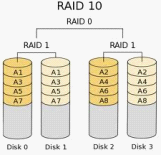Data Recovery -> RAID 10
Storage devices
Types of HDD
Partition Series
Linux
Operating Systems
Windows
RAID 10
 RAID 10 is the combination of RAID 0 and RAID 1. It applies parity check to realize striping set of mirror. So it inherits speediness of RAID 0 and security of RAID 1. It is known that RAID is a redundancy backup array and RAID 0 is an array responsible for data read and write. It is only one type of RAID 10 shown by picture 6. In most cases, it strips the main path into two branches to do Stripping operation which means data partition. And each is stripped again to do Mirroring operation which means mirroring for each other.
RAID 10 is the combination of RAID 0 and RAID 1. It applies parity check to realize striping set of mirror. So it inherits speediness of RAID 0 and security of RAID 1. It is known that RAID is a redundancy backup array and RAID 0 is an array responsible for data read and write. It is only one type of RAID 10 shown by picture 6. In most cases, it strips the main path into two branches to do Stripping operation which means data partition. And each is stripped again to do Mirroring operation which means mirroring for each other.Brief Introduction
Higher reading and writing efficiency of RAID 0 and higher data protection and recovery ability of RAID1 make RAID 10 a level with higher cost performance. Almost all RAID control cards are in support of this level. But the storage capacity utilization rate of RAID 10 is as low as that of RAID, only 50%. So RAID 10 has high reliability and efficiency and contains a striping area and a mirror structure. Compared with RAID 5, RAID 10 provides better performance. But extensibility of this new structure is not good. Although the solution is used widely, it is more expensive.
Structure
The structure of RAID 10 is very simple. First of all, two independent RAID 1 are created. Then these two independent RAID1 constitute RAID 0. When data are written in this logical RAID, they are written in the 2 RAID1. In the picture, Disk 0 and Disk 1 constitute a RAID1, and Disk 2 and Disk 3 constitute the other RAID 1. And these two RAID 1 constitute RAID 0. If the data written in Disk 1 are 0, 1, 2, 3, the data written in Disk 2 will be 4, 5, 6, 7 and the data in Disk will be 0, 1, 2, 3. Therefore, the data location in these 3 disks is not same as that of RAID 1 and RAID 0, but they have features of the both.
Although RAID 10 solution causes waste of 50% disk space, it doubles the disk speed and data security of single damaged disk. And if damaged disks are nit in the same RAID 1, data security can be guaranteed all the same. In the picture above, even Disk is damaged; the whole logical disk can continue to work. When the damaged Disk 2 in RAID 10 need to be recovered, only a new disk is needed to replace it. Data are recovered according to the working principle of RAID 10 and the system runs normally in the process. And in picture8 it shows that the original data 0,2, 3, 5 can be synchronously recovered in the new Disk 2.
In general, RAID 0 is an executive array and RAID 1 is a data protection array in RAID 10. And RAID 10 has the same Fault-Tolerant ability as RAID 1. The system expense for Fault-Tolerant is the same as that for mirror operation. As RAID 0 is applied as run-level, RAID 10 has an efficient I/O broad band. Therefore, it is a perfect solution for users who want to improve the performance of system based on RAID 1. RAID 10 is suitable for users who need high performance, high Fault-Tolerant but small capacity. For example, it is suitable for database storage server.
RAID is also called stripping.of mirror array. Because data extraction is crossing disk like that in RAID and every disk has a corresponding mirror disk just as that in RAID 1, another expression of RAID 10 is RAID 0+1. RAID 10 provides 100% data redundancy an supports larger volume, but its price is also higher. RAID provides best performance in the applications which need redundancy without considering the price. RAID 10 can guarantee higher security. Even two physical drivers fail, in every array; the data can still be protected. 4+2*N (N≥0) disk drives are needed in RAID 10, and only half capacity (even smaller when disk size differs) van be applied. For example, 4 disks of 250G are used in RAID and its actual capacity is 500G.